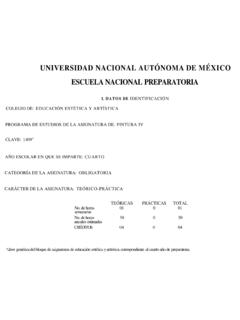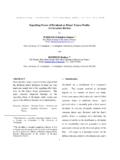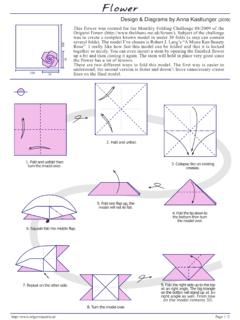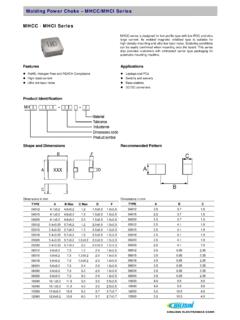Transcription of Identification of Adulterants by Pharmacognostical ...
1 International Journal of Research in Pharmacy and Biosciences Volume 2, Issue 2, February 2015, PP 1-4 ISSN 2394-5885 (Print) & ISSN 2394-5893 (Online) *Address for correspondence partha. International Journal of Research in pharmacy and Biosciences Vol 2 Issue 2 February 2015 1 Identification of Adulterants by Pharmacognostical Evaluation: Tvak (Cinnamomum Zeylanicum blume .) & Naluka/Cassia [Cinnamomum Cassia (Nees & ) ] Nanda Amalesh1, Paul Nirankush1, Gupta Amartya Kumar1, Ganguly Partha*1, Banerjee Dipankar1, Singh Rahul1, Katiyar Chandrakant1 1R&D Healthcare Division, Emami Ltd., 13 Road, Belghoria, Kolkata-700 056, India ABSTRACT Traditional medical systems remain important resources of healthcare worldwide that are reported to be safe and produce minimum side effects compared to synthetic medicines.
2 At present deforestation and extinction of many species and incorrect Identification of many plants has resulted in adulteration of raw drugs which results in lesser efficacy of the finished formulations? This article throws light on the concepts of adulteration of Naluka/Cassia (Cinnamomum cassia) with Tvak (Cinnamomum zeylanicum). Morphologically near about same, and Tvak is typically more expensive than the Naluka, so it is easy to adulterate Tvak with inferior variety of Naluka to reduce the cost. But there is no instantaneous ready method available to distinguish between Tvak and Naluka. A rough distinction can be made between Tvak and Naluka depending upon the Coumarin content [1] which requires sophisticated analytical technique which involves both time and cost.
3 In the present study, an easy attempt has been made to distinguish between Tvak and Naluka using simple Pharmacognostical simple microscopic and macroscopic characters can be used as an effective tool for the Identification of true Tvak sample which will help to maintain the quality of herbal drugs by avoiding adulteration of Naluka. Keywords: Tvak, Naluka/Cassia, Adulterants , Pharmacognosy. INTRODUCTION Ayurveda can be seen as one of the most visible faces of alternative medicines practiced throughout India. Now-a-days there is a growing tendency towards natural care. Therefore herbal therapies made a huge comeback. The major hurdle in the wider acceptability of Ayurveda and its products is the lack of proper standardization techniques of raw materials used in manufacturing.
4 Most of the raw materials come from plant source. These raw materials often adulterated with same herb of low quality or with similar looking different herbs. In general, adulteration is considered as profit related intentional malpractice. However, in raw material trade unintentional adulteration also exists. Tvak is the dried inner bark of stem of Cinnamomum zeylanicum blume [2] (Fam. Lauraceae), a moderate sized evergreen tree usually attaining a height of m, cultivated on the Western Ghats and adjoining hills, bark collected during April-July and October-December. It is commonly known as Dalchini. In English it is known as Cinnamon. It is widely used as a spice for its flavour, aroma & taste. The principal constituents are essential oils, tannins and mucilage.
5 Cinnamon bark is used for gastrointestinal (GI) upset, diarrhea, and gas. It is also used for stimulating appetite; for infections caused by bacteria and parasitic worms; for the common cold, and the flu (influenza) [3]. Cinnamomum cassia, called Chinese cassia or Chinese cinnamon, is an evergreen tree originating in southern China, and widely cultivated there and elsewhere in southern and eastern Asia (India, Indonesia, Laos, Malaysia, Taiwan, Thailand, and Vietnam). It is one of several species of Cinnamomum used primarily for their aromatic bark, which is used as a spice. The tree grows to 10 15 m tall, with greyish bark and hard, elongated leaves that are 10 15 cm long and have a decidedly reddish colour when young.
6 Chinese cassia is a close relative to Ceylon cinnamon (C. verum) [4]. Due to a blood-thinning component called coumarin, which could damage the liver if Nanda Amalesh et al. Identification of Adulterants by Pharmacognostical Evaluation: Tvak (Cinnamomum zeylanicum blume .) & Naluka/Cassia [Cinnamomum Cassia (Nees & ) ] 2 International Journal of Research in pharmacy and Biosciences Vol 2 Issue 2 February 2015 taken in huge amounts, European health agencies have warned against consuming high amounts of cassia [5]. Other possible toxins founds in the bark/powder are cinnamaldehyde and styrene [6]. In this study first, simple macroscopical evaluation was performed through naked eye. The stem barks of two plants were examined organoleptically.
7 Tvak and Naluka were differentiated on the basis of their external color, surface character, and texture along with taste. The mucilage content was checked by dipping both of the barks in water for 30 minutes and it was visibly different in amount. Then microscopical examination was performed using a compound microscope (Labomed; Model: LX 300) and suitable apparatus and reagents. MATERIALS AND METHODS Collection of Samples The samples were collected from a local market of Kolkata, West Bengal, India. Macroscopic and Physical Examination The morphological study was done by observing the following characteristics of the samples: Color Color of the samples was observed by viewing in white background in presence of sufficient light.
8 Surface Character It includes the thickness of the barks, character of both inner and outer surface, type of quill of the barks. Texture of Bark Texture of the barks was evaluated by viewing as well as touching the surface. Taste After proper washing, a small piece of sample was kept in mouth and chewed to perceive their taste properly. Content of Mucilage Mucilage content was examined by dipping both samples in water for 30 minutes. Then the samples were taken out of the water and mucilaginous content was observed both by viewing and rubbing between fingers. Microscopical Examination Sample Preparation The samples were dipped in water for 3 hrs to soften the hard material. Sectioning Sections were taken as thinner as possible, using a sharp blade having enough amount of water on its edge that prevents air bubble trapping in sections.
9 Then the sections were transferred into a watch glass containing water with the help of a brush. Mounting of Sections Clean glass micro slides was taken and sections were transferred with the help of a brush. One or two drops of water were added with a dropper. A clean coverslip, with the help of a needle and forcep, is placed over the section gently without air bubble trapping. The excess water was wiped out using a tissue paper. Staining of Sections The sections were stained in iodine solution by keeping for 2-3 mins into the solutions. Observing Under Microscope Both the stained and unstained sections were observed under 40 x magnifications in a compound microscope (Labomed; Model-LX 300). At the same time the observations were noted down.
10 Nanda Amalesh et al. Identification of Adulterants by Pharmacognostical Evaluation: Tvak (Cinnamomum zeylanicum blume .) & Naluka/Cassia [Cinnamomum Cassia (Nees & ) ] International Journal of Research in pharmacy and Biosciences Vol 2 Issue 2 February 2015 3 RESULTS AND DISCUSSION Macroscopical Evaluation Macroscopical evaluation of the sample instantaneously tells the difference between them. All the characters, as mentioned above, proved to be non-identical. The observations are incorporated in Table-No. 1. Table1. Macroscopical characters of Tvak and Naluka Parameter Tvak Naluka Colour Light brown to tan color Reddish brown to dark brown Surface Character It is comparatively thinner. Curls from one side only and rolls up like a newspaper.






